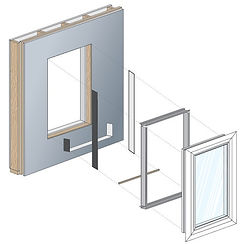Full-frame installation
A window is much more than just the glass panes - a full-frame window retrofit is also referred to as a brick to brick replacement and that adequately sums up what this process involves. A full-frame installation refers to the entire window system, including the glass, frame and additional components such as spacers, being replaced. This is typically a very effective option since it involves an analysis of the surrounding space and ensures that any gaps/leakages can be caught and sealed.
This option targets both the glass part of the window and the adjacent frame and space which are also large sources of energy loss - in fact, it is more likely to see cracks or wear in the frame or the wall adjacent to windows than the glass itself - and it is also typically caught much later. If you're looking for a safer option of sealing every possible source of energy loss, a full-frame installation is a more appropriate option than just replacing the window. Since this involves taking out the entire frame, it is an intensive retrofit and requires both time and considerable financial commitment. It is also essential to refer to a professional for the replacement.
Different window components showing: the wall, spacers, frame and the window glass panes.
Image obtained from: Installpella, click on image for reference
2
The orientation of window changed/location
Window orientation plays a great role in how efficient your window is since depending on its location, the solar heat gain coefficient (SHGC) can impact your heating and cooling load. In Canadian winters, any heat gain through your windows will offset heating load requirements and in the winter, the Sun is oriented closer to the south so South-facing windows will have maximum heat absorption in the winter. This provides a benefit in the winter since the Sun is oriented closer to the north and therefore, minimum heat absorption will also offset cooling loads. Do not assume that every side of your house will require the same window type.
This passive heating in the winter is a tough option for already-built homes since it is expensive and time consuming to change the structure of the house. If you are in the process of building or buying a new home, this is a useful consideration to keep in mind.
Size of window
As mentioned throughout this website, every window is a high potential energy loss zone and therefore minimizing window area is the most efficient way to drop your energy bills. However, fresh outdoor air is essential for occupant health and the indoor environment. Reducing your window size requires more infill to maximize your insulated wall area and this has to be performed by a certified contractor with a license obtained from your municipal authority. When considering window size also account for the shape and joints since having a window with more joints, such as double latches, increases points of leakage and minimizes effectiveness.
1. Eco Choice. (October 10, 2018), How Different Types of Installation Affect the Price of Your Window. Retrieved from https://ecochoicewindows.ca/how-different-types-of-installation-affect-the-price-of-your-window/#:~:text=Typically%20labor%20for%20window%20installation,window%20you%20choose%20to%20purchase
2. U.S Department of Energy. (October 2010), Guide to Energy-Efficient Windows. Retrieved from https://www.energy.gov/sites/prod/files/guide_to_energy_efficient_windows.pdf
